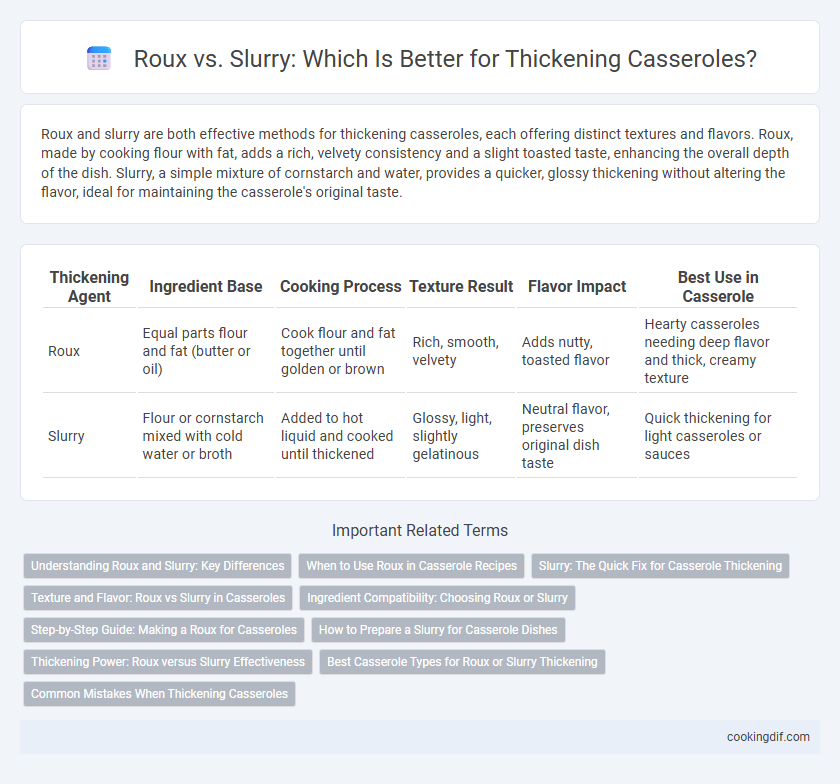Roux and slurry are both effective methods for thickening casseroles, each offering distinct textures and flavors. Roux, made by cooking flour with fat, adds a rich, velvety consistency and a slight toasted taste, enhancing the overall depth of the dish. Slurry, a simple mixture of cornstarch and water, provides a quicker, glossy thickening without altering the flavor, ideal for maintaining the casserole's original taste.
Table of Comparison
| Thickening Agent | Ingredient Base | Cooking Process | Texture Result | Flavor Impact | Best Use in Casserole |
|---|---|---|---|---|---|
| Roux | Equal parts flour and fat (butter or oil) | Cook flour and fat together until golden or brown | Rich, smooth, velvety | Adds nutty, toasted flavor | Hearty casseroles needing deep flavor and thick, creamy texture |
| Slurry | Flour or cornstarch mixed with cold water or broth | Added to hot liquid and cooked until thickened | Glossy, light, slightly gelatinous | Neutral flavor, preserves original dish taste | Quick thickening for light casseroles or sauces |
Understanding Roux and Slurry: Key Differences
Roux and slurry are essential thickening agents used in casseroles, with roux made by cooking equal parts fat and flour to form a paste, providing a rich, smooth texture and slightly nutty flavor. Slurry, a mixture of cold water and starch like cornstarch or flour, is added directly to hot liquid, thickening the casserole quickly without altering its flavor. Understanding the key differences in preparation, texture, and flavor impact helps cooks choose the best thickening method for their casserole dishes.
When to Use Roux in Casserole Recipes
Roux is ideal for casseroles that require a rich, velvety texture and deep flavor, as it combines equal parts fat and flour cooked until golden to develop complexity. Use roux when the casserole benefits from a thickener that can withstand longer cooking times without breaking down, such as in dishes with dairy or broth-based sauces. This method ensures a stable, smooth consistency, especially in casseroles like chicken pot pie or creamy vegetable bakes that are baked extensively.
Slurry: The Quick Fix for Casserole Thickening
Slurry, a simple mix of cornstarch and cold water, provides a quick and efficient method for thickening casseroles without the need for fat or lengthy cooking times. Unlike a roux, which requires cooking flour and fat together to develop flavor and texture, a slurry maintains a clear, glossy finish in the casserole sauce. This technique is favored for its speed and ease, especially in time-sensitive recipes or when a lighter consistency is desired.
Texture and Flavor: Roux vs Slurry in Casseroles
A roux, made from equal parts fat and flour cooked together, imparts a rich, velvety texture and deep, nutty flavor to casseroles, enhancing overall complexity. In contrast, a slurry, consisting of cornstarch or flour mixed with cold water, creates a clearer, glossy finish with a lighter mouthfeel, preserving the original flavors of the casserole ingredients. The choice between roux and slurry significantly influences the casserole's final consistency and taste profile, with roux offering creaminess and depth, while slurry provides a clean, smooth thickening effect.
Ingredient Compatibility: Choosing Roux or Slurry
Roux, made from equal parts fat and flour, offers a rich, buttery flavor that complements creamy, dairy-based casseroles, ensuring a smooth and velvety texture suitable for dishes with cheese or milk. Slurry, a mixture of cornstarch and cold water, provides a clear, neutral thickening effect ideal for casseroles with broths, tomato sauces, or soy-based liquids, preserving the original taste without added fat or flavor. Ingredient compatibility hinges on desired texture and flavor profile, with roux enhancing richness and slurry maintaining transparency and subtlety in the casserole base.
Step-by-Step Guide: Making a Roux for Casseroles
Making a roux for casseroles begins by melting equal parts butter and flour over medium heat, stirring constantly to form a smooth paste. Cook the mixture until it turns a light golden color, which typically takes 2 to 3 minutes, to eliminate the raw flour taste and develop a nutty flavor. Gradually whisk in broth or milk, continuing to stir until the sauce thickens to the desired consistency, ensuring a rich, velvety base that enhances the casserole's texture.
How to Prepare a Slurry for Casserole Dishes
To prepare a slurry for casserole thickening, combine equal parts cold water and starch such as cornstarch or flour in a small bowl, stirring until fully dissolved to avoid lumps. Gradually whisk the slurry into the hot casserole liquid, allowing it to simmer for a few minutes to achieve the desired thickness. This method provides a quick, smooth consistency without altering the casserole's flavor profile.
Thickening Power: Roux versus Slurry Effectiveness
Roux offers a stronger thickening power for casseroles due to its cooked flour-fat mixture, which creates a rich, velvety texture and helps prevent a raw flour taste. Slurry, made from cornstarch or flour mixed with cold water, thickens quickly but can result in a slightly translucent, less creamy consistency. For casseroles requiring long cooking times and robust thickness, roux provides more effective and stable thickening compared to slurry.
Best Casserole Types for Roux or Slurry Thickening
Casseroles with creamy sauces like chicken and broccoli or classic tuna noodle are best thickened with a roux, as its cooked flour base adds rich flavor and smooth texture. Soups or broth-based casseroles such as green bean or vegetable casseroles benefit more from a slurry made with cornstarch or flour mixed with water, which thickens quickly without altering flavor. Choosing the thickening agent depends on whether the dish requires depth and silkiness from a roux or a clear, neutral thickener from a slurry.
Common Mistakes When Thickening Casseroles
Using a roux for casserole thickening often leads to lumps if flour is not cooked sufficiently before adding liquid, causing uneven texture. Slurry mistakes include adding it directly to boiling casseroles without tempering, resulting in clumping and an undesirable starchy flavor. Properly blending and gradually incorporating thickening agents ensures smooth casserole consistency and optimal mouthfeel.
Roux vs Slurry for casserole thickening Infographic

 cookingdif.com
cookingdif.com